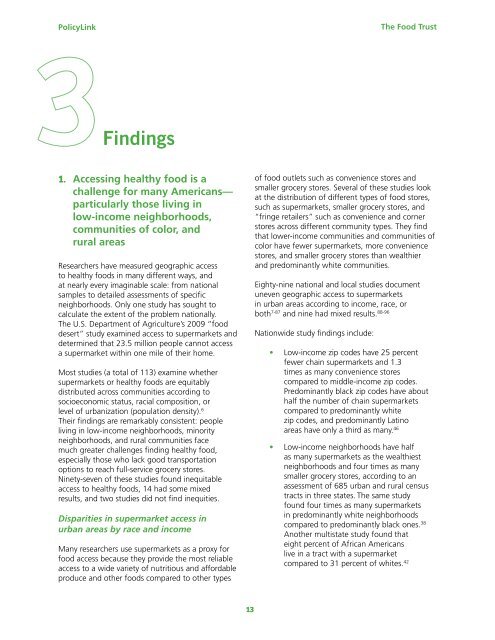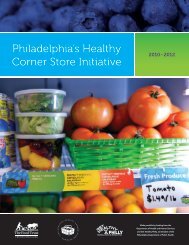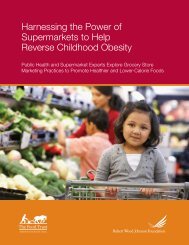The Grocery Gap: Who Has Access to Healthy - The Food Trust
The Grocery Gap: Who Has Access to Healthy - The Food Trust
The Grocery Gap: Who Has Access to Healthy - The Food Trust
You also want an ePaper? Increase the reach of your titles
YUMPU automatically turns print PDFs into web optimized ePapers that Google loves.
PolicyLink<strong>The</strong> <strong>Food</strong> <strong>Trust</strong>Findings1. <strong>Access</strong>ing healthy food is achallenge for many Americans—particularly those living inlow-income neighborhoods,communities of color, andrural areasResearchers have measured geographic access<strong>to</strong> healthy foods in many different ways, andat nearly every imaginable scale: from nationalsamples <strong>to</strong> detailed assessments of specificneighborhoods. Only one study has sought <strong>to</strong>calculate the extent of the problem nationally.<strong>The</strong> U.S. Department of Agriculture’s 2009 “fooddesert” study examined access <strong>to</strong> supermarkets anddetermined that 23.5 million people cannot accessa supermarket within one mile of their home.Most studies (a <strong>to</strong>tal of 113) examine whethersupermarkets or healthy foods are equitablydistributed across communities according <strong>to</strong>socioeconomic status, racial composition, orlevel of urbanization (population density). 6<strong>The</strong>ir findings are remarkably consistent: peopleliving in low-income neighborhoods, minorityneighborhoods, and rural communities facemuch greater challenges finding healthy food,especially those who lack good transportationoptions <strong>to</strong> reach full-service grocery s<strong>to</strong>res.Ninety-seven of these studies found inequitableaccess <strong>to</strong> healthy foods, 14 had some mixedresults, and two studies did not find inequities.Disparities in supermarket access inurban areas by race and incomeMany researchers use supermarkets as a proxy forfood access because they provide the most reliableaccess <strong>to</strong> a wide variety of nutritious and affordableproduce and other foods compared <strong>to</strong> other typesof food outlets such as convenience s<strong>to</strong>res andsmaller grocery s<strong>to</strong>res. Several of these studies lookat the distribution of different types of food s<strong>to</strong>res,such as supermarkets, smaller grocery s<strong>to</strong>res, and“fringe retailers” such as convenience and corners<strong>to</strong>res across different community types. <strong>The</strong>y findthat lower-income communities and communities ofcolor have fewer supermarkets, more conveniences<strong>to</strong>res, and smaller grocery s<strong>to</strong>res than wealthierand predominantly white communities.Eighty-nine national and local studies documentuneven geographic access <strong>to</strong> supermarketsin urban areas according <strong>to</strong> income, race, orboth 7-87 and nine had mixed results. 88-96Nationwide study findings include:• Low-income zip codes have 25 percentfewer chain supermarkets and 1.3times as many convenience s<strong>to</strong>rescompared <strong>to</strong> middle-income zip codes.Predominantly black zip codes have abouthalf the number of chain supermarketscompared <strong>to</strong> predominantly whitezip codes, and predominantly Latinoareas have only a third as many. 46• Low-income neighborhoods have halfas many supermarkets as the wealthiestneighborhoods and four times as manysmaller grocery s<strong>to</strong>res, according <strong>to</strong> anassessment of 685 urban and rural censustracts in three states. <strong>The</strong> same studyfound four times as many supermarketsin predominantly white neighborhoodscompared <strong>to</strong> predominantly black ones. 38Another multistate study found thateight percent of African Americanslive in a tract with a supermarketcompared <strong>to</strong> 31 percent of whites. 4213






